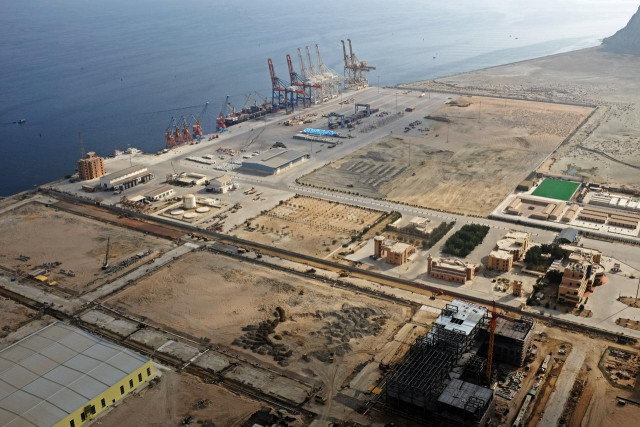China versus the US model of doing business — and CPEC
China's model of economy is better than the darkness Pakistan lived with for more than 50 years of US-Pak relations

A general view of Gwadar port in Gwadar, Balochistan. PHOTO: REUTERS
In her speech, Wells has raised a few questions for Pakistan to consider, before blindly pursuing a relationship that would benefit China more than Pakistan in the long-run. Her overarching argument from which flowed the rest of her reasoning has been that the BRI is about making regional countries hamstrung to China, because of the process applied to grant loans, which is obscure, non-transparent, unverifiable and falling short of international standards. Hence with this opacity surrounding China’s lending practices, there is a definite potential of all the projects to fuel corruption and raise the cost of doing business over time.
Many CPEC projects, according to Wells, have gone several slots up in cost, resulting in a corresponding hike in debt. In this case, she referred to the energy projects being built under CPEC.
The cost does not rise only because of variance in currency rates, or due to inflationary pressures over time, but also because of the capacity of the projects that do not sync with the assimilation ability of the system in place.
According to the report “Reckless Commissioning in Energy Sector”, published in Matrix magazine, Pakistan’s capacity to produce electricity has increased to 35,521 megawatts (MW) against the actual demand of less than 20,000. This excess capacity, according to the report, could multiply to 45,000 MW if all the renewable and fossil fuel energy projects get completed by 2030. According to the law, a minimum of 70 per cent capacity charges are guaranteed to the power-producing companies, whether the state buys electricity or not. This “unused and unpurchased” electricity, claims the report, will cost the national exchequer millions of rupees.
Another criticality towards which Wells raised question was the business model China has offered to Pakistan, which, according to her, deviates from the one that China had used to gain its economic growth. That model, argued Wells, was not solely based on opening up China to foreign investors, it was envisioned to create a labour market which, once trained and experienced under the aegis of foreign companies, would take China to the industrialisation path. For Pakistan, said Wells, China has adopted the model of: one, financing development through debt rather than investment; two, instead of upgrading the skills of Pakistani labour, China is sending its own labour to Pakistan; and three, rather than engaging local firms, contracts are given to Chinese companies. All these maneuverings, said Wells, eventually leads to the repatriation of the financed money to China, leaving Pakistan with the burden of debt only.
Not all that Wells has said could be termed a lame argument, though.
The concern about the rule of business governing the $60 billion CPEC project has been making rounds ever since the project has begun. Other than hearing that CPEC is a game-changer, nothing appealing to sanity has been offered in response to purportedly non-transparent nature of the CPEC-related projects.
What solution did Wells offer to Pakistan?
The US model of doing business. This model is based on the framework of sustained economic development which — together with good governance, long-term capacity-building mechanism, and market policies — would enable the private sector to flourish and bring prosperity and stability to countries.
Wells hinted at the Pakistan business development partnership model which, according to her, has not only contributed to sustained economic growth to develop Pakistan, but has also developed Pakistan’s infrastructure and capacity in education, health, energy, agriculture and law enforcement. Wells underlined that these were grants, not loans.
However, Wells’ appreciation of the IMF programme for Pakistan and calling it reform-oriented is hyperbolic.
Countries after countries in Latin America and Asia have been trapped by the IMF without showing any sign of development. Rather most of the countries have fallen prey to the manipulative design of the US-led West, the financers of the loan, to become their handmaiden for the advancement of their imperial agenda of amassing territorial and economic influence.
Argentina is a case in point. Since ages, as it seems now, the country is borrowing from the IMF without showing any fiscal discipline. Every loan has opened a new poverty chasm. That instead of refusing new debt on account of its consistent failure to payback, the IMF has been pumping more funds into the Argentina economy explains the US desire to keep its backyard swamped in poverty, internal conflict, and political turmoil. It pays in two ways — one, most of the Latin American countries, because of social unrest, could not use their natural resources optimally to break out of the poverty jinx; two, the US does not have to worry about balancing power in its immediate neighbour.
The capitalist Western economic powers have clearly been using ‘unseen hands’ to extract surplus from the developing countries and introducing them to the processes and values that clearly do not add to their economic worth.
The bad news is that the US-installed business model far from bringing development had pushed Pakistan farther into the abyss of economic darkness. Therefore, the Chinese model of economic growth that ties trade with infrastructure development is better than the darkness that Pakistan had lived with for more than 50 years of the US-Pakistan relations.
Published in The Express Tribune, November 28th, 2019.
Like Opinion & Editorial on Facebook, follow @ETOpEd on Twitter to receive all updates on all our daily pieces.
















COMMENTS
Comments are moderated and generally will be posted if they are on-topic and not abusive.
For more information, please see our Comments FAQ